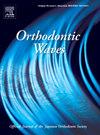苏丹成年人样本的软组织头影测量规范。第一部分:Legan与Burstone分析
IF 0.5
Q4 DENTISTRY, ORAL SURGERY & MEDICINE
引用次数: 2
摘要
目的:建立苏丹成年人正颌手术样本的软组织头颅测量规范。材料和方法:采用Legan和Burstone头侧测量法对年龄在18至25岁(平均22.8岁)的苏丹成年人(55名女性和51名男性)的106张侧位脑电图进行手工追踪和分析。结果:与高加索人相比,苏丹人的轮廓更凸,凸角更大,上颌更前倾,下脸喉角钝化,鼻唇角更尖锐,上下唇突出,唇沟更深,上颌切牙暴露更大,唇间隙更大。男性上颌和下颌前突明显大于女性,下脸喉角钝角和垂直高度深度比明显大于女性。女性有较大的垂直唇颏比、上颌切牙外露和唇间隙。结论:苏丹人和白种人成年人的软组织结构存在显著差异,苏丹人和其他人群的软组织结构也存在显著差异。在正颌手术的诊断和治疗计划中应考虑到这些差异。本文章由计算机程序翻译,如有差异,请以英文原文为准。
Soft tissues cephalometric norms for a sample of Sudanese adults. Part I: Legan and Burstone analysis
ABSTRACT Purpose: To establish soft tissues cephalometric norms for orthognathic surgery in a sample of Sudanese adults. Materials and Methods: A total of 106 lateral cephalograms of Sudanese adults (55 females and 51 males) aged between 18 and 25 years (mean 22.8 years) were manually traced and analysed using Legan and Burstone Cephalometric analysis for orthognathic Surgery (COGS). Results: Sudanese sample, in comparison to Caucasian, had a more convex profile with larger angle of convexity and more prognathic maxillae, obtuse lower face-throat angle, more acute nasolabial angle, protrusive upper and lower lips with deeper labiomental sulci and greater maxillary incisors exposure with larger interlabial gap. Males had greater maxillary and mandibular prognathism, more obtuse lower face-throat angle and vertical height depth ratio than females. Females had larger vertical lip chin ratio, maxillary incisor exposure and interlabial gap. Conclusion: Considerable differences between the soft tissue profile configuration of Sudanese and Caucasian adults exist and also between Sudanese and other populations. These variations should be taken into account during diagnosis and treatment planning of orthognathic surgery.
求助全文
通过发布文献求助,成功后即可免费获取论文全文。
去求助
来源期刊

Orthodontic Waves
DENTISTRY, ORAL SURGERY & MEDICINE-
CiteScore
0.40
自引率
0.00%
发文量
0
期刊介绍:
Orthodontic Waves is the official publication of the Japanese Orthodontic Society. The aim of this journal is to foster the advancement of orthodontic research and practice. The journal seeks to publish original articles (i) definitive reports of wide interest to the orthodontic community, (ii) Case Reports and (iii) Short Communications. Research papers stand on the scientific basis of orthodontics. Clinical topics covered include all techniques and approaches to treatment planning. All submissions are subject to peer review.
 求助内容:
求助内容: 应助结果提醒方式:
应助结果提醒方式:


